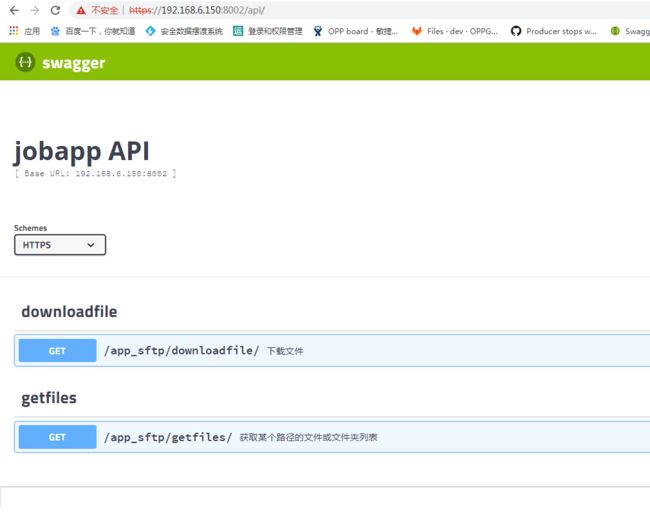经过两个星期的研究,终于做出来了。之前看了很多博客都是创建数据库去增加参数,但不是我想要的。因此就没有使用数据库去增加参数。
背景介绍:因为公司java人员开发出来一个自己的swagger界面,因为领导就说python是不是应该也可以开发出swagger界面呢?因此就把此任务交给刚入职3个月的员工、
一、环境搭建:
软件版本自己也试了好多版,终于弄了一个适合公司的版本。本次python版本是2.7.12。下面可能是你需要安装的软件包。请按顺序安装即可。
pytz==2019.1
django==1.11.22
simplejson==3.16.0
djangorestframework == 3.9.4
MarkupSafe == 1.1.1
Jinja2==2.10.1
coreschema==0.0.4
itypes==1.1.0
uritemplate==3.0.0
setuptools_scm==3.3.2
setuptools==40.8.0
pytest_runner==5.0
certifi==2019.6.16
urllib3==1.25.2
chrdet==3.0.3
requests==2.22.0
coreapi==2.3.3
openapi-codec==1.3.1
django-rest-swagger == 2.2.0
二、创建一个公共的swagger_schema.py
#-*- coding:UTF-8 -*- import yaml from urlparse import urljoin from rest_framework.compat import coreapi from rest_framework.schemas.generators import is_custom_action from rest_framework.schemas.inspectors import AutoSchema class CustomViewSchema(AutoSchema): def get_link(self, path, method, base_url): if hasattr(self.view, 'action'): action = self.view.action else: action = '' if not is_custom_action(action): return super(CustomViewSchema, self).get_link(path, method, base_url) fields = self.get_path_fields(path, method) yaml_doc = None if self.view and self.view.__doc__: try: yaml_doc = yaml.load(self.view.__doc__) except: yaml_doc = None if yaml_doc and 'desc' in yaml_doc: desc = yaml_doc.get('desc', '') _method_desc = desc params = yaml_doc.get('parameters', []) for i in params: _name = i.get('name') _desc = i.get('desc') _required = i.get('required', True) _type = i.get('type') _location = i.get('location', 'query') f = coreapi.Field( name=_name, location=_location, required=_required, description=_desc, type=_type ) fields.append(f) else: _method_desc = self.view.__doc__ if self.view and self.view.__doc__ else '' fields += self.get_serializer_fields(path, method) fields += self.get_pagination_fields(path, method) fields += self.get_filter_fields(path, method) te = [] for field in fields: if field.location in 'query': te.append(field.location) if fields and any(te): encoding = self.get_encoding(path, method) else: encoding = None if base_url and path.startswith('/'): path = path[1:] return coreapi.Link( url=urljoin(base_url, path), encoding=encoding, action=method.lower(), fields=fields, description=_method_desc )
三、在自己的django项目中的APP修改views
from common.swagger_schema import CustomViewSchema from rest_framework.decorators import api_view,schema @api_view(['GET']) #可以改为POST方法等 @schema(CustomViewSchema()) def getfiles(request): """ desc: 获取某个路 parameters: - name: spath desc: 远程的地址, type: string #控制你输入的类型,比如字符串、数字等 required: true #控制参数是否为必选项 location: query #可以修改为form等 - name: ip desc: 远程ip type: string required: true location: query - name: port desc: 远程端口, type: string required: true location: query - name: username desc: 远程ip的用户 type: string required: true location: query - name: password desc: 远程ip的密码 type: string required: true location: query """ spath = request.GET.get("spath",".") ip = request.GET.get("ip","") port = request.GET.get("port",22) username = request.GET.get("username","") password = request.GET.get("password","") return HttpResponse('get')
四、修改项目根目录下的setting
1、在 INSTALLED_APPS 中增加
rest_framework_swagger 和 rest_framework
五、修改项目根目录下的url
from rest_framework.schemas import get_schema_view from rest_framework_swagger.renderers import SwaggerUIRenderer, OpenAPIRenderer schema_view = get_schema_view(title='jobapp API',renderer_classes=[OpenAPIRenderer, SwaggerUIRenderer]) urlpatterns = [ url(r'^admin/', admin.site.urls), url(r'^app/', include(device_urls)),#这个是你自己创建的app url(r'^api-auth/', include('rest_framework.urls', namespace='rest_framework')), url(r'^api/', schema_view), ]
做到这一步,使用runsever应该就可以出现swagger界面。但是公司使用的uwsgi启动项目的,因此还要继续往下走。
要使用uwsgi需要配置nginx的。
六、执行 python manage.py collectstatic 从setting中的INSTALLED_APPS 去收集static。
会出现一个目录collected_static。里面有三个文件:admin rest_framework rest_framework_swagger
七、在项目根目录下的setting下修改
STATIC_URL = '/static/'
STATIC_ROOT = os.path.join(BASE_DIR, 'collected_static')
STATICFILES_DIRS = (
os.path.join(BASE_DIR, "static"),
)
八、在uwsgi.ini文件下增加
static-map = /static=/home/appuser/jobapp/collected_static
